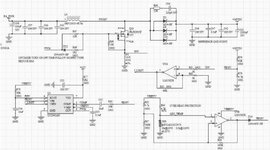DT_11
Newbie level 4
I am designing 2 boost converters, but am going in circles doing so. All design exercises with them I've done gave us a frequency. I've been given nothing of the sort here, so I'm lost.
Circuit 01 Specs:
Any help, be it with selecting a transistor or anything to do with this circuit design, is greatly appreciated.
Circuit 01 Specs:
- Input voltage of 3.6V.
- Output voltage of 5V.
- Output voltage ripple of < 0.5V (< 10% of output voltage with a min load current of 1A).
- Input voltage of 3.6V.
- Output voltage of 12V.
- Output voltage ripple of < 1.2V (< 10% of output voltage with a min load current of 1A).
Any help, be it with selecting a transistor or anything to do with this circuit design, is greatly appreciated.
